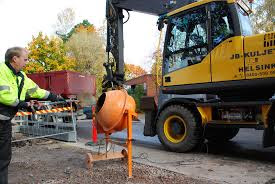(1) Basic and concrete foundation must be designed tower crane track checking, before use of acceptance, built around the foundation should slope and drainage facilities, and maintain a safe distance from the pit.
(2) tower crane disassembly must be equipped with the following persons: holders of certificates of safety assessment project leader and head of security, mechanical management personnel;
construction machinery of special operations have qualifications construction crane assembly and disassembly work, play heavy driver, lifting signal workers, rigging workers and other special operations operators.
(3) Working personnel should wear safety protection products, when high operating seatbelts, familiar and earnestly implement the dismantling process and procedures.
(4) Each member must check the hydraulic jacking system connections before lifting. Lifting prohibited swing arm and other job.
(5) After the
tower crane installation, the overall technical inspection and adjustment, after a phased machine inspection and, before delivery. In the wireless load cases, vertical deviation of the tower and the ground shall not exceed 4/1000.
Reliable housing (6) metal structure tower crane, track and all electrical equipment should be reliable grounding device, grounding resistance should be greater than 4Ω, and the establishment of lightning protection devices.
(7) Before operation, the surrounding circumstances must work environment, with roads, overhead wires, buildings and component weight and distribution of the scene to conduct a comprehensive understanding. When the tower crane operation, shall be no obstruction in the tower crane boom pole landing and turning radius, and a safe distance from overhead transmission wires should be specified.
(8) tower crane commanding officers, the operator must be certified, the job should be strictly enforced signal commanding officers, such as confusion or error signal, the operator should be rejected.
(9) Before carrying tower crane slewing, luffing, walking and lifting hooks and other actions, the operator should check whether the power supply voltage 380V, the range of variation does not exceed + 20V / a lOV, before the power control switch should start at zero and shall indicate the song.
(10) The tower crane boom luffing limiter, walking limiter, torque limiter, height limiter hook and a variety of travel limit switches and other safety devices, must be safe complete, sensitive and reliable, can not be adjusted and dismantling . Non-limiting device instead of using the operating mechanism.
(11) shall not exceed the mechanical load tower crane and lifting objects of unknown quality. Must be used under special circumstances, it must go through checking, approved by the person in charge of enterprise technology, and to have someone on-site monitoring, but not more than 10% of limit load.
(12) when a sudden power failure, all controllers should immediately appropriated zero, disconnect the power switch, and take measures to secure the weight down to the ground, the air suspension after prolonged periods of heavy lifting.
(13) when lifting heavy banding smooth, firm, can not be hung or stacked objects scattered on the weight. Sporadic materials and articles must be secured in place by lashing back before lifting hoists or wire rope. Do not use tower crane were the oblique, oblique lifting and lifting an underground or heavy condensation on the ground.
(14) In case of 6 or higher winds or rain, snow, fog and other inclement weather, the outdoor tower crane operation should be stopped. When the job after the snow or rain or snow, take a test crane, rear brake operation can be carried out to confirm sensitive and reliable.
(15) reaches the rated lifting tower crane lifting loads of 90% or more by weight should be first lifted from the ground 20 ~ 50cm stop upgrading, check the following items: the crane's stability, reliability brakes, the weight smoothness, firmness banding.
(16) weight lifting and lowering speed to be uniform, non unsteadiness and sudden braking. Action to turn around smoothly, when the rotation is not completely stopped before the action shall not be repercussions. Non-gravity drop tower crane, non-load free fall.
 A portable concrete mixer provides an economical solution for do-it-yourself concrete projects. A mixer eliminates the need for backbreaking manual labor to mix up small batches of concrete. Both electric and gasoline-fueled mixers may be rented out by the hour or day. The equipment can be rolled right on site to build the slab for a garden shed or walkway.
A portable concrete mixer provides an economical solution for do-it-yourself concrete projects. A mixer eliminates the need for backbreaking manual labor to mix up small batches of concrete. Both electric and gasoline-fueled mixers may be rented out by the hour or day. The equipment can be rolled right on site to build the slab for a garden shed or walkway.













